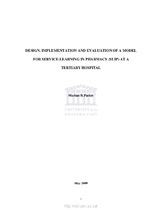| dc.description.abstract | Background
In recent years the focus of pharmacy practice has changed from being primarily ‘drugcentred to’ one which is ‘patient-centred’ (El-Awady et al., 2006, p.1). Developments in pharmacy curricula worldwide are reflecting this change. Pharmacy courses no longer concentrate primarily on theoretical content, but increasingly on the ability of students to apply their theoretical knowledge in practice.The South African Pharmacy Council (SAPC) requires that pharmacy education and training in South Africa equips pharmacists for the roles they will take on in practice. In order to accomplish this, the SAPC has prescribed competency unit standards for entry level pharmacists which may serve as a guide for pharmacy educators. A significant challenge in pharmacy education is the application of theory in practice settings(Bucciarelli et al., 2007), which possibly affects the ability of entry-level pharmacists to meet the SAPC unit standard competencies. The dire shortage of pharmacists in public sector health settings further emphasizes the need for a level of competency of entry level pharmacists so that they may enter the workplace ready to serve the medicine related
needs of society.Service-learning is defined as experiential learning in which students engage in structured activities that address community needs and promote learning. The purpose of this study was to design, implement and evaluate a Service-learning in Pharmacy (SLIP) intervention which is intended to serve as a generic model which can be used in tertiary hospital pharmacies. The SLIP intervention aimed to promote student learning by providing opportunities for students to engage in structured activities, while simultaneously alleviating pharmacy workload.Methods: The study was directed to UWC final year pharmacy students and pharmacists employed at a hospital pharmacy. Qualitative and quantitative research methods were used in evaluating this pre- and post-intervention enquiry. Qualitative evaluation methods included pre- and post- focus group discussions with students to assess student knowledge and expectations of SLIP. Covert observation of pharmacists was used to assess current views and receptivity toward student activities during the SLIP course. Quantitative evaluation methods included pre- and post-intervention student competency assessments in areas of hospital pharmacy practice (compounding, dispensing and clinic/ward pharmacy), and pre- and post-intervention questionnaires which assessed pharmacists’ views and receptivity toward SLIP.
Results Students (n=16) and pharmacists (n=9) who were involved in the intervention comprised the study cohort.Qualitative: Pre-intervention, students indicated a lack of confidence and apprehension toward SLIP. Pharmacy managers were anxious about lack of time and space and the additional burden of training students. Post- intervention, students experienced a sense of professionalism and could connect with varied theoretical knowledge. They were both enthusiastic about this style of learning (“saw the pharmacy profession with new eyes”) and realized the need for more skills development in clinical pharmacy. Pharmacists’ receptivity to SLIP increased once student contribution to service delivery became evident.Quantitative: Student competency in areas of hospital pharmacy practice increased as a result of their participation in the Tygerberg SLIP model. Students also made a valuable contribution to service delivery at Tygerberg hospital pharmacy. This was quantified as the total number of services in compounding (n= 807), dispensing (n=2090) and clinic/ward services (n= 37).
Conclusion:The SLIP intervention resulted in improved perceptions and receptivity of pharmacists to service learning initiatives. Students’ level of competency increased in hospital pharmacy practice and they contributed to service delivery at Tygerberg hospital pharmacy. Further studies are needed to evaluate the impact of the SLIP model on patient care and health
outcomes. | en_US |

